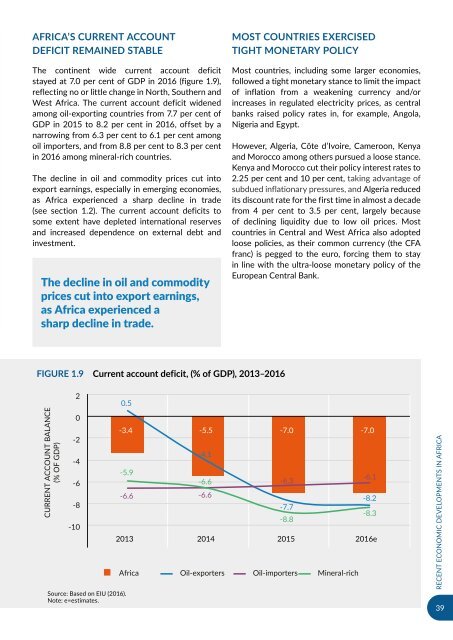URBANIZATION AND INDUSTRIALIZATION
Economic%20Report%20on%20Africa%202017%20UNECA
Economic%20Report%20on%20Africa%202017%20UNECA
Create successful ePaper yourself
Turn your PDF publications into a flip-book with our unique Google optimized e-Paper software.
AFRICA’S CURRENT ACCOUNT<br />
DEFICIT REMAINED STABLE<br />
The continent wide current account deficit<br />
stayed at 7.0 per cent of GDP in 2016 (figure 1.9),<br />
reflecting no or little change in North, Southern and<br />
West Africa. The current account deficit widened<br />
among oil-exporting countries from 7.7 per cent of<br />
GDP in 2015 to 8.2 per cent in 2016, offset by a<br />
narrowing from 6.3 per cent to 6.1 per cent among<br />
oil importers, and from 8.8 per cent to 8.3 per cent<br />
in 2016 among mineral-rich countries.<br />
The decline in oil and commodity prices cut into<br />
export earnings, especially in emerging economies,<br />
as Africa experienced a sharp decline in trade<br />
(see section 1.2). The current account deficits to<br />
some extent have depleted international reserves<br />
and increased dependence on external debt and<br />
investment.<br />
The decline in oil and commodity<br />
prices cut into export earnings,<br />
as Africa experienced a<br />
sharp decline in trade.<br />
MOST COUNTRIES EXERCISED<br />
TIGHT MONETARY POLICY<br />
Most countries, including some larger economies,<br />
followed a tight monetary stance to limit the impact<br />
of inflation from a weakening currency and/or<br />
increases in regulated electricity prices, as central<br />
banks raised policy rates in, for example, Angola,<br />
Nigeria and Egypt.<br />
However, Algeria, Côte d’Ivoire, Cameroon, Kenya<br />
and Morocco among others pursued a loose stance.<br />
Kenya and Morocco cut their policy interest rates to<br />
2.25 per cent and 10 per cent, taking advantage of<br />
subdued inflationary pressures, and Algeria reduced<br />
its discount rate for the first time in almost a decade<br />
from 4 per cent to 3.5 per cent, largely because<br />
of declining liquidity due to low oil prices. Most<br />
countries in Central and West Africa also adopted<br />
loose policies, as their common currency (the CFA<br />
franc) is pegged to the euro, forcing them to stay<br />
in line with the ultra-loose monetary policy of the<br />
European Central Bank.<br />
Figure 1.9 Current account deficit, (% of GDP), 2013–2016<br />
CURRENT ACCOUNT BALANCE<br />
(% OF GDP)<br />
2<br />
0<br />
-2<br />
-4<br />
-6<br />
-8<br />
-10<br />
Source: Based on EIU (2016).<br />
Note: e=estimates.<br />
0.5<br />
-3.4 -5.5 -7.0 -7.0<br />
-5.9<br />
-6.6<br />
-4.1<br />
-6.6 -6.3<br />
-6.6<br />
-7.7<br />
-8.8<br />
-6.1<br />
-8.2<br />
-8.3<br />
2013 2014 2015 2016e<br />
Africa Oil-exporters Oil-importers Mineral-rich<br />
RECENT ECONOMIC DEVELOPMENTS IN AFRICA<br />
39


